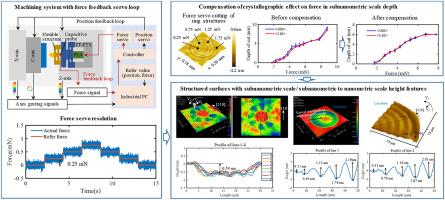Controllable diamond cutting of structured surfaces with subnanometric height features on silicon
Abstract
Diamond cutting with a controllable depth of cut at the subnanometric scale is desired for next-generation electronics and optics. However, due to the limits of positioning accuracy of the current machine tools, diamond cutting at subnanometric scale depths remains in realm of molecular dynamic (MD) simulations instead of engineering realization. Cutting force feedback and control is regarded as a potential method to improve the positioning accuracy of machine tools. In this study, an ultra-precision force feedback loop with the resolution down to submillinewton is employed and integrated on an ultra-precision machine tool to enable the capability of cutting at subnanometric scale depth. By this way, the relationship between the cutting force and such small depth of cut needs to be well studied. MD simulations are conducted in this study to analyze the mechanism of material removal and influence of the crystallographic effect on the actual cutting depth and force caused by varied cutting directions at subnanometric to nanometric scale depth in diamond turning. Then, the crystallographic effect of silicon with the depth of cut from subnanometric to nanometric scale is compensated experimentally for accurate cutting at such an extremely small scale. Controllable diamond cutting of structured surfaces with actual depths and amplitudes ranging from several angstroms to a few nanometers on silicon is successfully realized.


 求助内容:
求助内容: 应助结果提醒方式:
应助结果提醒方式:


